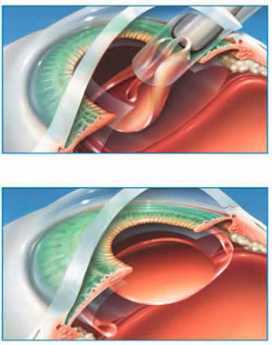Related Topics
Philadelphia Medicine (2)
Philadelphia is where medicine began in America
Old Age, Re-designed
A grumpy analysis of future trends from a member of the Grumpy Generation.
Cataracts

|
| Cataract Surgery |
At a social gathering of older Americans, if someone excitedly announces he has just had successful cataract surgery, the chances are good that every other person in the group will reply they have had it, too. Those who have had two eyes operated have slightly more social clout than those who have had only one, but in general soft lens implants are what everybody has. It's pretty common to meet someone for lunch who had a cataract operation that morning. What a contrast from the olde days. Until about 1970, having a cataract removed was a matter of spending two weeks in a darkened room in the hospital, with your head held in sandbags to keep you from moving. And the result, while better than nothing, was the need to wear glasses so thick they resembled the bottom of cocoa-cola bottles and narrowed the visual field to the end of a tunnel. Those who had cataract surgery forty years ago had to be nearly blind before the risk of surgery was justified.
 Everybody gets cataracts, and almost everybody is cured. 
|
| Dr. Fisher |
There was a reason for this, relating to a blinding eye condition known as sympathetic ophthalmitis. The most harrowing of dangers associated with eye surgery was the tendency for an injured eye to become allergic to itself, and hence also allergic to the opposite eye, soon leading to total blindness in both eyes. Eye surgery was nothing to fool with, and it was particularly dangerous to have a foreign body like a piece of flying glass enter the eyeball. And then, came the Battle of Britain, where so many owe so much to so few.
The British pilots were flying Spitfires, a type of airplane with a large plexiglass canopy over the pilot, allowing him to look in all directions for the enemy. The German Messerschmidt pilots would swoop down on the Spitfires, machine guns blazing. The Spitfires were not necessarily shot down when they were hit, but many of them had shattered chards of plexiglass sprayed into the cockpit, and many of the splinters went into the British pilot's eyes. If they managed to land the planes, the British doctors administered emergency first aid, stopped major bleeding, fixed major broken bones. In the heat of the emergency, no one noticed that bits of plexiglass were being left in the eyeballs.
Eventually, these survivors were being treated for scars and injuries in clinics, long after the war. One British opthalmologist suddenly had a striking insight. These eyes, with buried foreign bodies in them, were working just fine. No sympathetic ophthalmitis; that wasn't supposed to happen. Ultimately, the realization spread that plexiglass could be used as a lens implant, and many patients were successfully treated with a so-called hard lens.
The next advance was the soft lens. Someone realized that soft plastic, like a soft rubber ball, has a memory. Squeeze it out of shape, and it will soon return to its original shape. So, in effect, a soft lens of the proper size and shape can be squeezed into a toothpaste tube, injected into the right place in an eye, and it will pop back into shape. Before this can be done, of course, the rotten old lens has to be removed in any of several ways; pluck it out with eyebrow tweezers, or buzz it into liquid by lasers or other means, suck out the juice and squeeze the squashed-up soft plastic lens into place. With practice, the whole thing can be done in ten minutes. That's modern cataract surgery, and it's pretty slick, especially if you know what the struggles were, before the Spitfires.
But don't let me overstate matters. This operation still has its risks. The retina behind the lens may turn out to have been defective, so a new lens hardly helps very much. Or there can be a slip, which amounts to one drop of blood getting where it doesn't belong, and the eye or both eyes are ruined. When I had my eye fixed, I seemed to be lying on the stretcher, waiting for a lot longer than necessary. Suddenly, I heard operating room doors banging open, and several older physicians in street clothes came in, huddled around, talked with each other for a long time, walked slowly back out into the corridor. I knew exactly what that was all about, and it didn't improve my serenity. Eventually, a nurse came around and asked if I was ready for my surgery, and I said, Well yes, I guess so.
Originally published: Wednesday, July 15, 2009; most-recently modified: Sunday, July 21, 2019
| Posted by: Augusto | Mar 13, 2012 1:38 AM |